Golf: Reducing your risk of injury and improving your game
05/17/2005
Furci Home / Fitness Channel / Bullz-Eye Home
In an article I wrote five years ago, I addressed the importance of strength training for golfers. In this article, I wanted to focus on preventing injuries and targeting the specific muscles used while playing golf.
The mechanics of a golf swing can cause a variety of injuries. The most common area golfers experience injuries is the lower back. Other areas golfers complain about are the shoulder, or more specifically the rotator cuff, the left elbow, and the left wrist (for right handers). Unfortunately, there is little data available about the seriousness of injuries as a result of playing golf or how to reduce them. However, if we apply what we know from other sports through research and empirical data, I have seen many golfers not only decrease their risk of injury but improve their game.
What golfer in their right mind wouldn’t want to improve his game? As a matter of fact, golfers, more than participants in any other sport, are fanatical. There are more than 20 million golfers in the US and most of them are obsessed with their abilities on the course. They will drop $700 on an iron and $400 for a driver. Many will pay thousands of dollars to belong to prestigious country clubs. Many more will spend hundreds of dollars during the golf season on balls that they’re eventually going to lose. But the average golfer won’t spend a dime on improving his biggest asset to his game: his body. I cannot imagine owning a $2,000 set of clubs and not doing anything to ensure I could use them to their fullest capacity.
To be successful at golf, you need functional strength, flexibility, endurance (ability to hit the club well, over and over), coordination, finesse and timing. You can’t find these aspects of the game in a pro shop. I don’t care how much you paid for your Big Bertha Fusion Irons or your balls that claim to go 20 to 40 yards farther than ordinary balls; if you lack the above, you’re going to be another frustrated player.
The repetitive nature of the game can lead to fatigue of the primary muscles used to swing the club. Over time this can lead to cumulative injury disorder, or CID. This disorder is caused by several factors. The abdominal, oblique and erector spinea are the muscles used most in a golf swing. A serious golfer spends hours bent over a ball. This position puts excessive strain on the lower back. Repetitive effort like bending over and swinging makes muscles tighten. When a muscle is tight it tends to weaken and when a muscle weakens it tends to tighten. Add to this the shearing force of a swing and you have a recipe for disaster. As a result of weak and tight muscles, the internal forces acting on these tissues rise. If these forces are high enough, injury and inflammation will result.
Increasing the strength and flexibility of the primary muscles involved is imperative to improving your game and staying injury free. Learning how to properly warm-up not only before you perform exercises but before you play is the first step toward longer drives and reduced risk of injury. A proper warm-up increases tissue temperature, which leads to an increase in flexibility and the intensity of muscular contractions. Another physiological response to warming up is increased tissue perfusion or oxygen delivery to the muscles utilized.
A proper warm-up isn’t swinging a driver five or 10 times before letting it rip, or a couple of toe-touches before a workout. A warm-up done correctly will last between 10 and 15 minutes and can include a variety of exercises. You could include calisthenics such as jumping jacks, knee bends and jogging in place or, if you prefer to warm-up inside, you could walk briskly on a treadmill. Next, if you’re going to be golfing, perform practice swings. Start off by going through the motions with half swings. Gradually increase the speed and extent of the practice swings until you are at game speed. Now you’re ready to let it rip.
For the following exercises, perform two sets of 10 to 15 repetitions each. If you can perform two sets of 15 with a particular weight, it's time to increase the amount you’re lifting. If you can't do at least 10 repetitions, the weight is too heavy. If you can’t perform 10 repetitions while using your body weight, do as many as you can. Your strength will increase over time.
Stiff Arm Stability Ball Crunch
This is one of my favorites. It is by far one of the most effective exercises you can do. When performing this exercise, make sure your starting position is slightly rounded over the ball. Starting in this manner will ensure that you work the abs throughout their full range of motion. You can hold a dumbbell or plate as your strength increases.
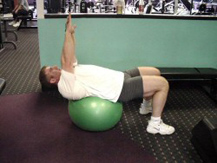 |
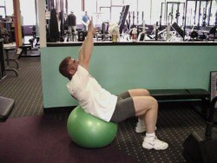 |
Stability Ball Wood Chops
When performing this exercise, make sure to bend at the trunk. Do not use your arms to move the weight. Once you get set in the starting position, your arm angles in relation to your body should remain the same throughout the exercise.
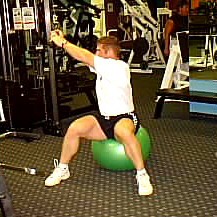 |
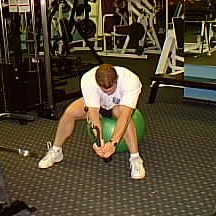 |
Stability Ball Knee Tucks
This particular exercise is torture. Make sure to not let your back sway when your legs are fully extended. Your core should remain tight.
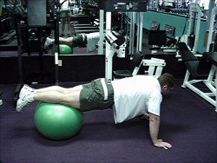 |
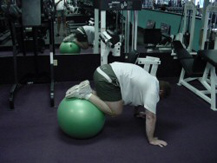 |
Half Superman’s
This is a great exercise for building strength, stability and balance in the lower back and glutes. If this exercise is too difficult on a ball, do it on the floor. As your abilities increase you can advance to the ball. Perform two sets for each side, holding the position for 30 seconds.
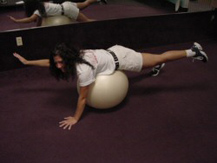 |
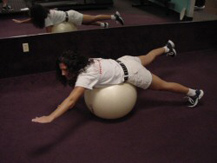 |
Stretching
The jury is still out when it comes to stretching. Does it help prevent injuries? Most experts agree that it does. The big question is when the stretching should be done. Many studies have shown that stretching before an activity will cause a reduction in peak force. What does that mean? In layman's terms, repeated stretching before you golf can cause a reduction in how far you hit the ball. Obviously this is not what you want. Therefore, many experts, including myself, believe that the best time to stretch is after your activity. When it comes to stretching before and while golfing, I recommend that my clients do light stretches intermittently.
Spinal Twist
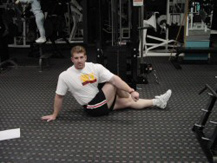
Muscles affected: Spinal erectors, internal and external obliques. (Lower back)
- Sit with your legs straight and your upper body almost vertical.
- Place the back of your left elbow on the back of your right knee.
- Place your right palm on the floor directly behind your hips.
- Push your right knee to the left with your left elbow while turning your shoulders and head to the right as far as possible.
- Hold for 10 seconds, relax, then hold for 10 more.
- Repeat with the left leg.
Supine Knee Flex
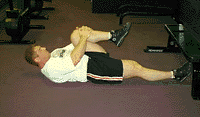
Muscles affected: Gluteus maximus and hamstrings.
- Lie on your back with your legs straight.
- Flex your right leg, and pull your knee toward your chest with both hands.
- Keep your shoulders back and leg on the ground throughout the movement.
- Hold for a count of 10, twice with each leg.
Side Bend with Bent Arm
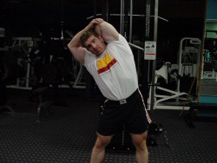
- Stand with your feet slightly wider than shoulder width.
- Raise your right elbow above your head and grasp it with your left hand.
- Pull your elbow behind your head, keeping your arm bent.
- Without bending your knees, lean to the left as far as possible.
- Hold for a count of 10, twice on each side.
Seated Hamstrings
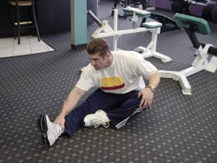
- Lie on the floor with one leg straight.
- Bend the other leg so the bottom of your foot is toward your knee.
- Slowly pull your chest toward your knee.
- Hold for a count of 10, twice for each leg
ALSO:Don't miss Mike's previous article on the ways strength training can improve your golf game.
Questions or comments? Send them to mike@bullz-eye.com.
You can follow us on Twitter and Facebook for content updates. Also, sign up for our email list for weekly updates and check us out on Google+ as well.













